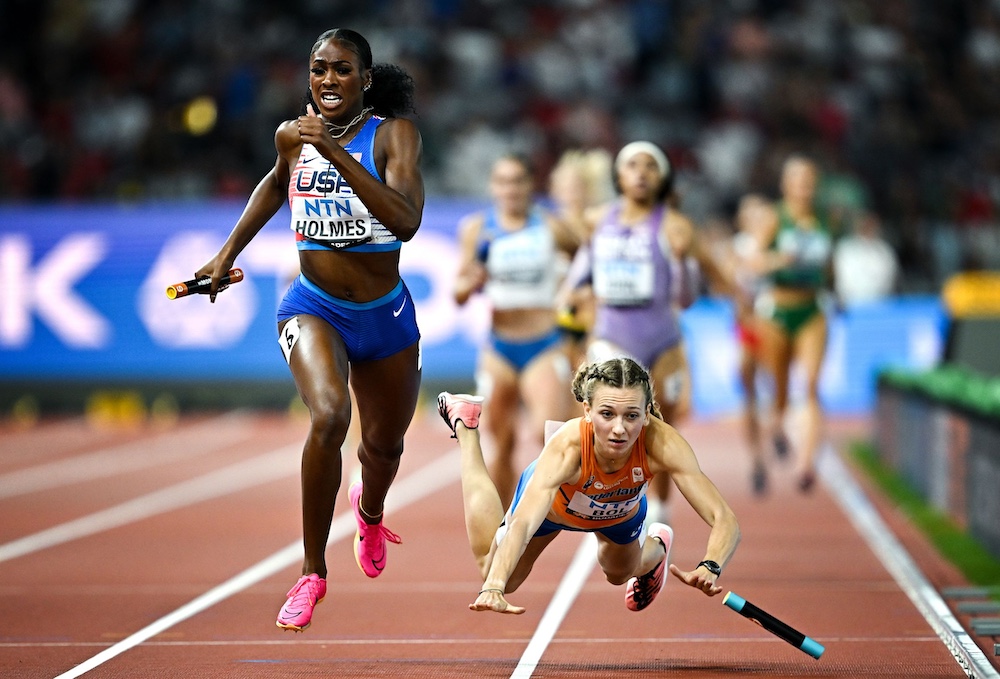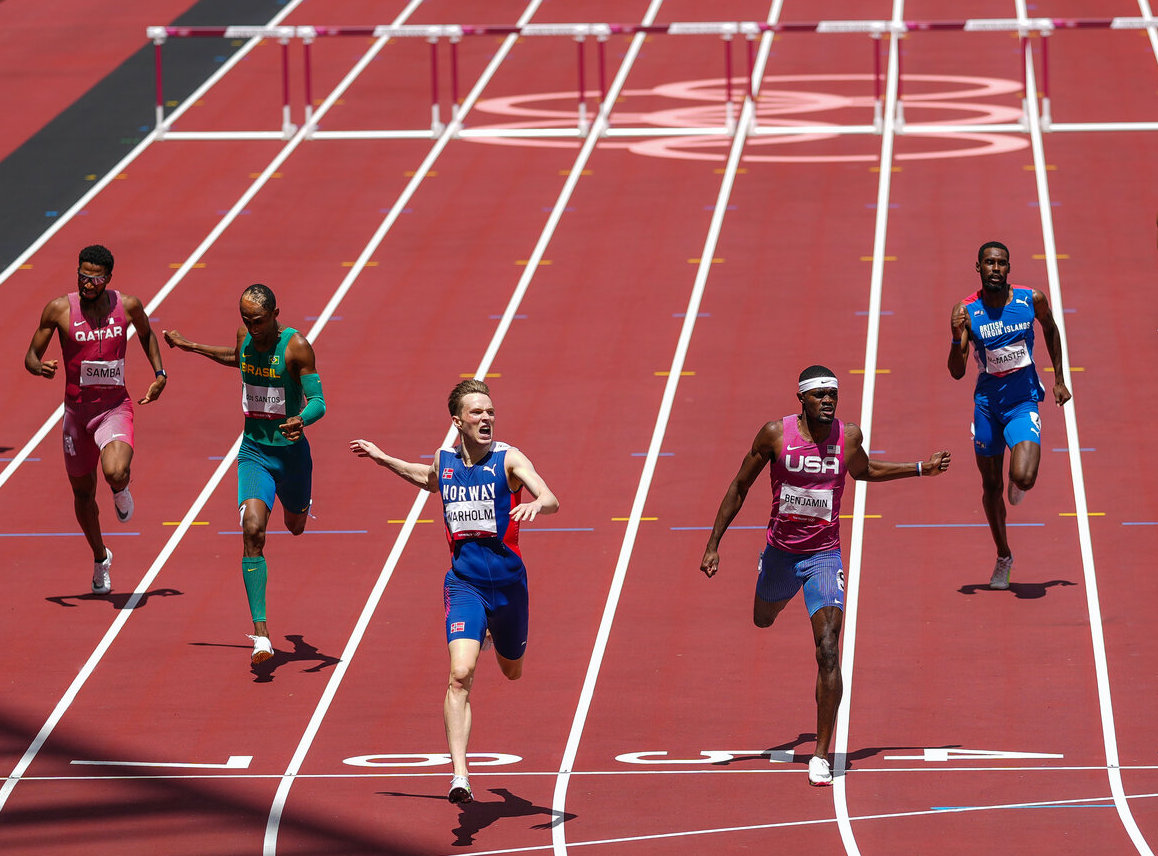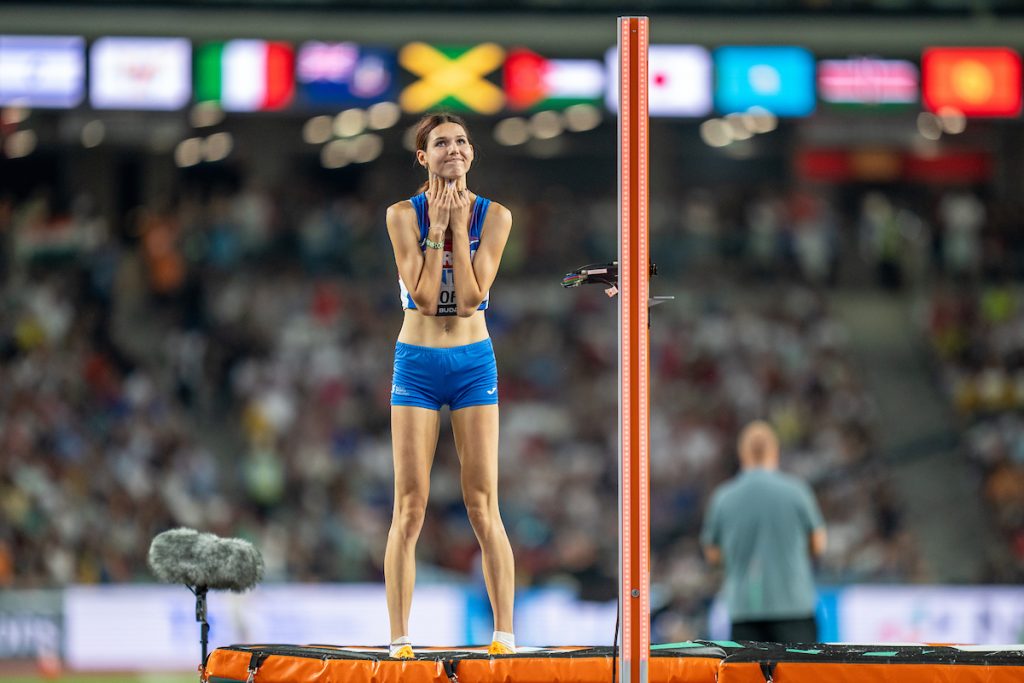I have written a special article on Tentoglou's victory at the championships. As I explained there, Tentoglou almost did not make it to the final: after the two first attempts he was sitting at the 13th place. Fortunately he kept his cool and qualified with his third jump at 8.25 m. But the qualifiers had several victims, among them Shreesankar, who was 7th at last year's World's and has a 8.41 m personal best, to say nothing of the young talents M. Furlani and B. Saraboyukov. And in the final a minor surprise was the below-par performance of S. Ehammer who could not make it to the final 8.
The regular readers of this blog know that I am a great fan of I. Vuleta (Spanovic). For me, she is the best female long jumper of the past decade. She has a perfect style and now that she is able to produce regularly 7+ m jumps she is accumulating gold medals. The qualifications saw J. Sawyers, M. Bekh-Romanchuk, Q. Burks, M. Gardasevic and M. Vicente eliminated. In the final Vuleta opened with a foul at 7+ m and T. Davis-Woodhall took the lead with 6.91 m (which was enough for silver). But at the second jump already Vuleta showed that she was going for the gold with 7.05 m. And she consolidated her place with a 7.14 m jump at her fifth attempt. E. Brume was 3rd up to the last jump but then A. Rotaru-Kottmann pushed her out of the medals with a 6.88 m jump. L. Iapichino, following in the steps of her mother, F. May, was fifth, a net improvement over her last year's performance in Eugene. There was a minor drama in the final with, as protagonist, A. Smith. But this is a story I will tell in some other article of mine.

There was also some drama in the men's triple jump. P. Pichardo being absent due to injury, the main favourite was 18 years old jamaican jumper J. Hibbert. He qualified with a 17.70 m (which would have sufficed for gold in the final). But then he got injured in his very first jump, which he could not complete, and had to be carried out of the stadium. Following this the way was clear for H.F. Jango who won his first world title with a 17.64 m jump, succeeding thus his coach T. Tamgho who had won the world title in 2013.Women's triple jump almost turned into a huge surprise. The indisputable favourite, Y. Rojas, world champion in the past three editions, started the competition by fouling a 15+ m jump and then had two bizarre jumps at 14.33 and 14.26 m. But she got lucky. K. Orji had just one valid jump at 14.33 m and so, thanks to her 14.26, Rojas could progress for the final three attempts as 8th. And she went on to foul her next two jumps. I had to, a posteriori, peruse the livestream of the women's triple jump in order to follow Rojas' efforts. In fact her fouled jumps were one at around 15.20 m and one at slightly over 15 m. So entering the last attempt Rojas was sitting at 8th place while M. Bekh-Romanchuk was first with 15.00 m, L. Pérez-Hernandez second with 14.96 m and T. Lafond third with 14.90 m. And then Rojas had a valid jump at 15.08 m ending the suspense and winning her fourth world title. S. Ricketts jumped 14.93 m at her sixth attempt but that was no more sufficient for a medal.

Barshim and Tamberi carrying Barshim's young son
Two years ago G. Tamberi and M. Barshim shared an olympic gold in Tokyo for men's high jump at 2.37 m, not missing a single attempt up to that height. Last year Barshim was alone at the highest position on the podium winning the world title with 2.37 m, Tamberi losing the bronze medal on countback. This year the outcome was different. It started with a big scare for Tamberi who needed three tries at 2.28 m in order to qualify for the final. However once in the final he had an (almost) exemplary competition winning with 2.36 m before two tries at 2.38 and one at 2.40 m. J. Harrison was leading up to 2.33 m but missing the first try at 2.36 m lost the first place on countback (but this was still a redemption after his failure last year in Eugene, where he had finished 9th). Barshim, curiously, had three unsuccessful attempts at 2.36 m and had to content himself with bronze.
Last year in Eugene, E. Patterson beat Y. Mahuchikh, for the women's high jump world title, on countback with 2.02 m while Valortigara obtained bronze with 2.00 m beating I. Herashchenko on countback. This year Patterson was not at top shape having been injured in the off season. Still she fought all the way to 1.99 m, beating her compatriot N. Olyslagers on countback. Y. Mahuchikh was already leading at that height but she went on to pass 2.01 m before three unsuccessful attempts at 2.07 m.
There was no surprise at the men's pole vault. There were five athletes at 5.90 m and still four at 5.95 m. When the bar was raised to 6.00 m Duplantis passed at the first attempt while E. Obiena needed two. The competition was essentially over at that point: Duplantis went on to pass 6.05 and 6.10 m, Obiena failing once at the first height and twice at the second. Then the bar was raised to a potential world record of 6.23 m but Duplantis could not make it. (Less than a month latter he would succeed at that height in the same venue as the 2022 World's).
Duplantis jumping 6.23 m at the Diamond League final (after the championships)
K. Moon, still under her maiden's name of Nageotte, won last year's world title, S. Morris finishing second and N. Kennedy third. This year the event started with a (minor) surprise of the non-qualification of K. Stefanidi who no-heighted at 4.50 m. The final saw S. Morris exiting at 4.65 m for a 7th place. At 4.80 m there were just four athletes left. W. Murto won bronze on countback from T. Sutej at that height, while K. Moon and N. Kennedy went on to pass 4.85 and 4.90 m, the latter at the third attempt. Having both just one miss at some previous height they were tied at first position. and, following the Tamberi-Barshim Tokyo example they decided, after a short friendly discussion, to stop there and share the gold. That was one of the great moments of the championships, and, to my eyes, a display of fair-play.

C. Ealey won the women's shot put world title, just as she did last year in Eugene, with a 20.43 m throw. S. Mitton was second with a 20.08 m thrown while L. Gong managed to obtain a medal with 19.69 m on countback from A. Dongmo. The latter is probably the last of the elite glider throwers since women, have followed the example of men and became in their quasi-totality spinners. M. Ewen who has the world leading performance this year with 20.45 m, could do no better than 6th, a minor disappointment.R. Crouser led the men's shot put competition from the outset. L. Fabbri obtained silver with a 22.34 m throw in his third attempt. T. Walsh was third with 22.05 m up to the fifth throw when J. Kovacs passed him with 22.12 m. When the last throw came nothing changed and Crouser free from any tension managed a great throw of 23.51 m at just 5 cm from hi world record.
Women's hammer throw was a tad sad with the elimination of the quadruple world champion A. Wlodarczyk in the qualifiers. (Last years world champion B. Andersen was also eliminated at the qualification stage). C. Rogers won the final with 77.22 m ahead of J. Kassanavoid both upgrading their medals with respect to Eugene, while D. Price, the 2019 champion, was back on the podium obtaining the bronze medal.The men's hammer saw a, mostly unknown, 21 years old E. Katzberg lead the qualifiers with 81.18 m. Such surprises are not rare in the qualification competition but, usually, the exceptional performances are not confirmed in the final. Well, in this case the situation was different. Five-time world champion P. Fajdek opened with a season best 80.00 m but in the end that performance was not good for a medal. B. Halasz took the lead with 80.82 m, and, in the end, that would be the only medal (a bronze) for the host nation. W. Nowicki passed him at the fourth attempt throwing just one cm further and in the fifth he increased his lead with 81.02 m. But at this point Katzberg reposted with 81.25 clinching the gold medal. Nobody could react at the last throw and Katzberg confirmed his supremacy with a 81.11 m last throw. Now we have to see how he fares in the future.
Last year V. Allman and S. Perkovic lost the women's discus throw gold medal to what I have dubbed a "lucky throw" by B. Feng. This year the nightmarish, for the favourites, scenario was repeated with L. Tausaga throwing a massive personal best 69.49 m in the fifth round and taking the lead. Allman could not improve her 69.23 m and had to settle for silver. B. Feng confirmed her progress with 68.20 for bronze, while S. Perkovic finished fifth. In my article "What is happening to the US throwers?" I had written about Tausaga pointing out that she managed to throw beyond the 64.20 m qualifying standard on her very last throw, securing thus a place in the team. Admittedly she is a rather young thrower but she has been throwing around 64 m since 2019. A 5 m jump in performance is more than surprising. Let's see if she confirms this next year.
After his 4th place last year in Eugene one could think that D. Stahl's return at the top of the men's discus hierarchy was impossible. All the more so since K. Ceh and M. Alekna had given proof of their talent, winning the World and European titles respectively. The competition in Budapest started with nobody reaching the automatic qualifying standard. But when the final arrived there were plenty of great throws. Ceh took command of the event with 69.27 m but in the fourth round Stahl passed him with barely 10 cm to spare. Alekna secured the third place with 68.85 . And then came the last throw. Ceh and Stahl were the last two to throw starting with Ceh. And he threw a massive 70.02 m taking the lead. But Stahl had not said his last word. He responded with a championships record of 71.46 m and the gold was his. I expected him to do his short celebration sprint but apparently he is past this phase: is he becoming blasé to his victories?
In the women's javelin the two young throwers I am following, E. Tzengko and A. Vilagos, winners of the European U23 and U20 titles respectively, had a disastrous competition at the qualifiers and were out of the final. The latter started with a lucky throw of 65.47 m by F.D. Ruiz Hurtado (she has not thrown beyond 63 m in the past six years) and with this performance she led the event till the last throw when H. Kitaguchi managed a throw of 66.73 m obtaining gold (she was outside the medals up to that point). K.L. Barber the 2019 and 2022 world champion could do no better than 7th.
Before talking about the javelin competition I would like to show you a short gif showing the portuguese thrower L. Ramos and his special somersault at the end of the throw. He is a young 24-year-old thrower with a 84.78 m record. I would be following him in the future to see if his technique will allow him to reach world-class performances.
The men's javelin throw saw the elimination of ex-world champions J. Yego and A. Peters, while K. Walcott was absent due to injury. (One wonders what happened to the great german trio of J. Vetter, T. Roehler and A. Hoffman who should have been present and dominating the event. I cross my finders hoping to see them back to top shape in some near future). N. Chopra won the event with 88.17 m but that was not a easy victory since A. Nadeem threw 87.82 obtaining silver with that throw. What was really surprising was the presence of three indian throwers in the final finishing 1st (Chopra), 5th (Jena) and 6th (Manu) the last two with throws over 84 m.

For those who are wondering how come indians start distinguishing themselves in this discipline, the answer is simple. The preferred pastime of indian boys is cricket. So once you become good at throwing the cricket ball, graduating to the javelin is just a matter of assimilating the technique. (Let us not forget that A. Vilagos came to javelin after having distinguished herself as a young girl in throwing the vortex. If you do not know what the latter is you can look it up in google). And of course the argument about indian throwers applies equally to pakistanis, like Nadeem. They have the same passion for cricket.










































